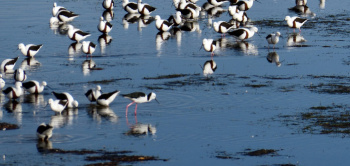
South Australian Science Teachers Association
The Adelaide International Bird Sanctuary: Bringing birds and conservation into your curriculum
Posted by SASTA
on 11/05/2022

by Bruce Baker, Environmental Science Educator
Adelaide is near the southern-most end of the East Asian-Australasian Flyway – a migratory pathway for waterbirds flying annually from South Australia to as far north as Siberia and Alaska. To visit with these birds all we need do is visit the Adelaide International Bird Sanctuary just north of Adelaide on the eastern side of Gulf St Vincent. Bruce Baker explains the significance and outlines resources available to schools.
The Adelaide International Bird Sanctuary (AIBS) National Park - Winaityinaityi Pangkara (Kaurna meaning ‘country for all birds’) is one of South Australia’s newest national parks, with the first part proclaimed in 2016. It is the largest park in the Adelaide region. The AIBS extends for over 60 km along the eastern coast of Gulf St Vincent, from St Kilda in the south, to Parham in the north. It is bordered seaward in part by the Adelaide Dolphin Sanctuary and a marine park.
AIBS has a significant biodiversity with over 260 species of flora and fauna. Some of these are endangered, threatened or vulnerable species and some are restricted to this region. Resident species such as the Slender-billed Thornbill (Acanthiza iredalei rosinae; bird), Bitterbush Blue Butterfly (Theclinesthes albocincta; insect), Heath Goanna (Varanus rosenbergi; reptile) and Bead Samphire (Tecticornia flabelliforis; plant) are found within the AIBS. So, whilst established for the protection of habitat for migratory birds, it serves a far wider conservation role.
Flyway
The AIBS is of global conservation significance. It is a major feeding area for over 27,000 migratory shorebirds between November and March each year. The AIBS is a terminal point on the East-Asia Australasian Flyway (EAAF) which goes from Siberia and Alaska to Australia passing through 22 countries. The EAAF is one of 8 recognised global flyways.
Birds
The bird species of the AIBS can be grouped as residents, migrants and vagrants. Residents inhabit the Sanctuary all year round. Migrants spend a part of the year living within the Sanctuary and travel to other parts of Australia and/or the world on a fairly regular schedule. Vagrants are rare visitors that appear from time to time, often when blown off course by storm conditions.
Research
In order to learn more about the migratory bird species it is necessary to capture and tag them. The shorebirds are trapped using cannon nets that are set facing seaward along the shoreline. The cannons have a small explosive charge which is triggered electronically. These fire projectiles with light netting attached. Researchers set the nets in areas known to be frequented by the desired species and lie in wait for a group of birds to forage along the shoreline in the target area. The cannons are fired casting the net over the top of the birds catching them before they take flight. Banders then run down the beach to retrieve the birds from the nets, carefully releasing them from the net and bagging them in soft cloth bags. The birds are grouped by species and transferred to holding enclosures to await processing.
Individuals are taken from these enclosures and biometric data is gathered and recorded. This includes such observations as wing length, head and beak length, state of moult and condition of the bird as well as body mass. Birds are then banded, flagged and released. Every effort is made to do this as efficiently as possible to minimise stress on the birds. It is important that this is done by trained individuals under the direct supervision of registered people.

Birds may be tagged with a metal band and coloured plastic leg flags with identification codes on them. Metal bands ensure long term identification and tracking of individuals as they may be recaptured in other parts of the world. Coloured and coded leg flags enable individuals to be identified by observers from a distance while they roost or forage. These may not last as long as the metal bands but do not require recapture to read. A few individuals have been fitted with satellite transmitters worn like a minute back pack weighing about 5g. These are obviously very expensive but enable researchers to track the global movements of individual birds remotely in almost real time. This presents some exciting and meaningful opportunities for the incorporation of ICT into students studying bird biology.
Regular counts by experienced observers have revealed that most migratory wader species are declining in numbers at rates as high as 8 percent each year for some species. This is thought to be largely due to habitat destruction such as the ‘reclaiming of land’ through the construction of sea walls and the infilling burying tidal flats and dredging to create shipping ports in industrialised areas. Such practices along the flyways destroy feeding grounds which are essential stopover points for long haul migrating species. These birds cannot simply find somewhere else to go. The distribution of suitable and very specific natured feeding grounds at the appropriate points and distances along their journey are essential for the survival of the species. Research can identify these unique areas and international collaborations can occur to ensure their protection and hence the long-term survival of the migratory species. In addition, conservation of these areas helps to safeguard habitat for local non-migratory species of birds as well as a great variety of other flora and fauna.
AIBS presents some unique opportunities for students of all ages to learn about the ecology of the area and older students may possibly be able to work with researchers on new and established projects.
Education Resources
NRM Education has made available some activities for primary school students and these are currently accessible on their website. I have developed, and am continuing to develop, teaching and learning resources for secondary students and teachers and map these against the Australian Curriculum. I hope to make a series of further resources accessible to teachers as I understand how time poor teachers are and how developing new resources with contemporary issues and aligning them with the Australian Curriculum can be very time consuming.
Educational resources developed to date include a simulation activity (‘game’) “That’s disturbing” that enables students to investigate the efficiency of foraging by shorebirds when confronted with various sources of disturbance and environmental change. A set of student activities headed “Management matters” enables students to put themselves in the role of a park manager and consider aspects which address the General Capabilities. Each activity has been mapped against the Content Descriptions (codes e.g. ACSSHE134) of the Australian Curriculum: Science.
Units of work tailored around the AIBS can readily and authentically address the General Capabilities and the Cross-curriculum Priorities of the Australian Curriculum.
General Capabilities
- Literacy
- Critical and Creative Thinking
- Information and Communication Technology (ICT) Capability
- Numeracy
- Intercultural Understanding
- Personal and Social Capability
- Ethical Understanding
Scientific vocabulary is often very specialised and needs to be developed in context. Particular terms may encapsulate an entire process or represent a complex concept. For example, “Migratory shorebirds may be classified as vulnerable due to habitat disturbance” is a short statement that is very dense in meaning. Conventions of classification and scientific nomenclature also extend student literacy.
Critical and Creative Thinking is developed through solving problems and making evidence-based decisions particularly in unfamiliar contexts such as those faced by a conservation manager.
ICT Capability is developed through use of data accessing and manipulation. Remote sensing, GIS and modelling skills are key to environmental management.
Numeracy Capability can be extended through the collection, analysis and presentation of data.
Intercultural Understanding is developed through examining issues through the lens of another culture. Students become more aware of the need for cultural sensitivity when debating issues that require a consensus between diverse groups such as international conservation agreements.
Personal and Social Capability involves developing decision making and communication skills, working independently and in collaboration with others. Multidisciplinary teams are required to address many environmental issues. Influencing the behaviour and attitudes of others can be crucial for implementing some conservation measures.
Ethical Understanding surrounds such matters as the treatment of animals, use of scientific information and science applications such as pest control measures in conservation areas.

Cross-curriculum Priorities
- Aboriginal and Torres Strait Islander Histories and Cultures
- Asia and Australia’s Engagement with Asia
- Sustainability
Kaurna people, as the traditional custodians of the Adelaide region, have been represented since the AIBS inception and have an important place on the management collective group. The Sanctuary contains sites of cultural significance including landforms described in dreaming and remains of middens. The birds themselves feature in dreaming and are important in Indigenous culture.
The birds of the EAAF provide a perfect natural connection between Asia and Australia due to the shared population on their migratory path. Important conservation agreements have been made between Australia and countries
such as China, Japan and Korea. Shorebird conservation is also incorporated into Asian cultural events such as the annual Moon Lantern Festival celebrated in Adelaide. Ecotourism also draws people from Asia and other parts of the world to the AIBS. Asian Australians also have a strong affiliation with the AIBS through community groups such as the Vietnamese Farmers Association who are represented on the management collective.
A key goal of the AIBS is to conserve habitat for the migratory shorebirds to ensure the survival of these populations. This is quite an explicit link to the priority of sustainability. In protecting habitat and shorebird populations other species also benefit from these conservation efforts.
Environmental Education
Environmental engagement of students is essential for their total well-being and for conservation of the natural environment. Environmental news is too often skewed towards doom and gloom. Such exposure fuels feelings of hopelessness and helplessness among young people. This can lead to mental health issues such as stress and depression. It is important to include good news as well as bad because both concern and hope motivate action. Furthermore, engagement with the natural environment addresses a modern phenomenon that has been termed ‘nature deficit disorder’.
Further information about the AIBS can be obtained from: https://www.parks.sa.gov.au/find-a-park/Browse_by_region/Adelaide/adelaide-international-bird-sanctuarynational-park#about
This article has been reproduced from the 2019 SASTA Journal Number 1. Previous issues of the SASTA Journal can be found in the members area.
Post categories
Environmental ScienceArchive
- July 2025
- June 2025
- May 2025
- April 2025
- March 2025
- February 2025
- January 2025
- December 2024
- November 2024
- October 2024
- September 2024
- August 2024
- July 2024
- June 2024
- May 2024
- April 2024
- March 2024
- February 2024
- December 2023
- November 2023
- October 2023
- September 2023
- July 2023
- June 2023
- May 2023
- April 2023
- March 2023
- February 2023
- January 2023
- December 2022
- November 2022
- October 2022
- August 2022
- July 2022
- June 2022
- May 2022
- April 2022
- March 2022
- February 2022
- January 2022
- December 2021
- November 2021
- October 2021
- September 2021
- August 2021
- July 2021
- June 2021
- May 2021
- April 2021
- March 2021
- February 2021
- January 2021
- December 2020
- November 2020
- October 2020
- September 2020
- August 2020
- July 2020
- June 2020
- May 2020
- April 2020
- October 2018
- September 2018
- August 2018
- July 2018
